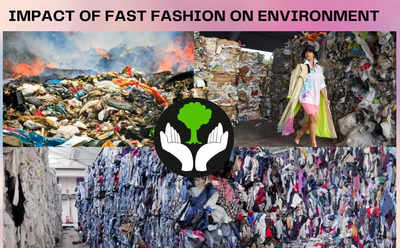The Dark Side of Fast Fashion: Exploring the Impacts on Environment

Impact of fast fashion on environment
By Sakshi Arora
Hello & Welcome tofast fashion series part 8, So today I’m going to put light on how changing our closet rapidly is directly putting negative impacts on our environment .
The major and the biggest issue with the fast fashion industry is its negative impact on our environment. Fast fashion is characterized by its high-speed turnover and manufacturing, which results in excessive resource consumption and the generation of a significant volume of textile waste. This business contributes significantly to water pollution, carbon emissions, and other environmental problems.
However, the pandemic has led to a growing awareness of the need for more environment friendly fashion practices. Consumers are searching for solutions to lessen their carbon footprint as they become more aware of how their actions affect the environment. In response, fast fashioncompanies have started prioritizing sustainability in their production process. Some companies use more environment friendly materials like organic cotton or recycled polyester. Others are concentrating on minimising waste by recycling used clothing or reusing leftover textiles.
Another issue that has come to light during the pandemic is the treatment of workers in the fast fashion industry. Many of the workers in fast fashion factories are located in developing countries, where labour laws and working conditions may not be as strict as in developed countries. The pandemic has highly highlighted & exposed the vulnerability of these workers, who often do not have access to adequate healthcare or social protections.
As a result, fast fashion companies are starting to put their employee’s safety and welfare first. To guarantee that employees are paid fairly and have access to healthcare and other benefits, several companies have formed programmes. Others are working to improve working conditions in factories and production facilities.
The pandemic has also brought attention to the need for fast fashion companies to be more adaptable and sensitive to changes in customer demand. There has been a decline in demand for several clothing categories, such as formal wear as with many people working from home and socializing less. Fast fashion companies will have a greater chance of thriving in the post-pandemic environment if they can swiftly adjust to these shifts in customer demand.
In conclusion, the COVID-19 pandemic has had a significant impact on the fast fashion industry, exposing its vulnerabilities and highlighting the need for more sustainable and ethical practices. While the pandemic has presented significant challenges for the industry, it has also provided an opportunity for fast fashion brands to re-evaluate their practices and adapt to the changing landscape of the fashion industry. Fast fashion brands can build a more resilient and sustainable future for themselves and the environment by putting sustainability, worker safety, and flexibility first.
I hope I gave you all some basic insights on fashion, See you all in the next blog!
Hello & Welcome to
The major and the biggest issue with the fast fashion industry is its negative impact on our environment. Fast fashion is characterized by its high-speed turnover and manufacturing, which results in excessive resource consumption and the generation of a significant volume of textile waste. This business contributes significantly to water pollution, carbon emissions, and other environmental problems.
However, the pandemic has led to a growing awareness of the need for more environment friendly fashion practices. Consumers are searching for solutions to lessen their carbon footprint as they become more aware of how their actions affect the environment. In response, fast fashion
Another issue that has come to light during the pandemic is the treatment of workers in the fast fashion industry. Many of the workers in fast fashion factories are located in developing countries, where labour laws and working conditions may not be as strict as in developed countries. The pandemic has highly highlighted & exposed the vulnerability of these workers, who often do not have access to adequate healthcare or social protections.
As a result, fast fashion companies are starting to put their employee’s safety and welfare first. To guarantee that employees are paid fairly and have access to healthcare and other benefits, several companies have formed programmes. Others are working to improve working conditions in factories and production facilities.
The pandemic has also brought attention to the need for fast fashion companies to be more adaptable and sensitive to changes in customer demand. There has been a decline in demand for several clothing categories, such as formal wear as with many people working from home and socializing less. Fast fashion companies will have a greater chance of thriving in the post-pandemic environment if they can swiftly adjust to these shifts in customer demand.
In conclusion, the COVID-19 pandemic has had a significant impact on the fast fashion industry, exposing its vulnerabilities and highlighting the need for more sustainable and ethical practices. While the pandemic has presented significant challenges for the industry, it has also provided an opportunity for fast fashion brands to re-evaluate their practices and adapt to the changing landscape of the fashion industry. Fast fashion brands can build a more resilient and sustainable future for themselves and the environment by putting sustainability, worker safety, and flexibility first.
I hope I gave you all some basic insights on fashion, See you all in the next blog!










Recent Messages ()
Please rate before posting your Review
SIGN IN WITH
Refrain from posting comments that are obscene, defamatory or inflammatory, and do not indulge in personal attacks, name calling or inciting hatred against any community. Help us delete comments that do not follow these guidelines by marking them offensive. Let's work together to keep the conversation civil.